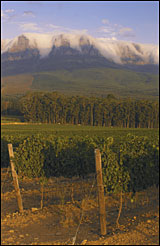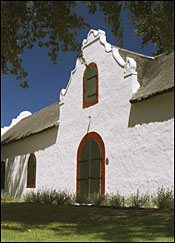I started assessing the wines of South Africa soon after they began returning to our shores in the 1990s. At that point, it seemed important to convey to readers that South Africa was no mere upstart as a wine producer, as it had 350 years of experience growing grapes and making wine in the greater Cape region. Experience counts for a lot in efforts to optimize grape varieties and growing sites. Moreover, mature vineyards are a very valuable resource for anyone aspiring to the highest quality levels in winemaking. So, when South African wines reappeared here after Nelson Mandela was elected president in 1994, I thought key story was not "New Wine Country Coming on Line" but "Established Wine Country Makes Comeback."
However, I'm now inclined to change my tune. After eight days of tasting, touring and talking with winemakers in South Africa earlier this month, I'd no longer introduce a novice to South African wine by highlighting how established it is. On the contrary: I'd note that this country's wine industry is essentially a new one, and is just now getting poised to show how good it can be.
 South Africa now has over 600 wine producers, which is fairly impressive, but what is most remarkable about that total is that it is nearly double the number from the year 2000. The industry has been thoroughly transformed since the mid-1990s, and especially since KWV co-op was privatized in 1997, permitting industry deregulation.
South Africa now has over 600 wine producers, which is fairly impressive, but what is most remarkable about that total is that it is nearly double the number from the year 2000. The industry has been thoroughly transformed since the mid-1990s, and especially since KWV co-op was privatized in 1997, permitting industry deregulation.
The leading transformational factors are easy enough to identify: Investment capital and talent from abroad began flowing into the country after being held back for years due to anti-apartheid sanctions. South Africans greatly increased the frequency of their travel to other wine producing countries for periods of study and work in top vineyards and cellars. Seriousness about the viticultural foundation of winemaking was greatly intensified, with particular attention to planting noble vine varieties and utilizing better plant material that was free of viruses and geared toward local conditions, lowered yields, and heightened quality.
Each of these factors is still actively reshaping South Africa's wine industry, and additional changes are arising from a push into cooler growing districts and an industry-wide recognition that the future lies in exporting high-end wines rather than low-cost ones.
Against this backdrop of dramatic change, it seems clear that many American consumers and members of the wine trade hold serious misconceptions regarding South African wine. Assuming that a very high percentage are not watching South Africa's industry closely, it is likely that most Americans think that it underwent a transformation sometime in the 1990s and then presented itself to the world in a relatively settled mode. However, the reality is that the industry has undergone multiple transformations, and I'm convinced that more has changed since 2000 than in the six-year span from 1994 to 2000.
 This is significant because those Americans who came to conclusions a few years back probably hold misconceptions about the wines as well as the industry that produces them. Many of the bottlings that re-introduced South African wine to Americans in the 1990s simply weren't up to snuff after years away from the rigors of international competition due to sanctions. A high percentage was marred by outmoded production techniques, unattractive packaging, or heat damage suffered in transit.
This is significant because those Americans who came to conclusions a few years back probably hold misconceptions about the wines as well as the industry that produces them. Many of the bottlings that re-introduced South African wine to Americans in the 1990s simply weren't up to snuff after years away from the rigors of international competition due to sanctions. A high percentage was marred by outmoded production techniques, unattractive packaging, or heat damage suffered in transit.
Those Americans who made up their minds about South African wine more than a couple of years ago are thus likely to have done so on the basis of wines that are unrepresentative of the current reality. A commercial shake-out has removed most of the disappointing products from circulation, and a second set of more careful importers is now bringing us wines that are much more consistent and attractive in all respects. Packaging and product integrity are now vastly improved, though I continue to hear occasional reports of wines that may have been compromised by heat.
I'll be back next month with another column on specific developments in South Africa, along with lots of reviews of wines from relatively new, cool climate regions such as Elgin and Walker Bay. As a preview of what's on the way, here are my impressions on some of South Africa's most important wine categories based on the hundreds of wines tasted there earlier this month:
Chenin Blanc: This remains South Africa's most widely-planted variety, and winemakers are taking it ever more seriously. Most wines fall into one of two categories: Simple, fresh and affordable, based on fermentation in stainless steel and early bottling to retain primary fruit characters, or richer and more complex, with old vine fruit accented by fermentation or ageing in oak. Both styles can be delicious and very interesting with food.
Sauvignon Blanc: I tasted many delicious Sauvignons from the 2005 vintage. Almost all are now wisely bottled under screw caps, and many wines cluster in a very useful niche. They have better aromatics and acidity than most California Sauvignons, but aren't quite as lean or aggressive as Marlborough bottlings from New Zealand. Many are medium-bodied but still very fresh and sharply defined.
Blended Reds: Beyond varietal bottlings of Cabernet or Merlot, South Africa is producing a very high percentage of blends. Fairly frequently it is a blend that fills the role of a winery's flagship bottling. Some are more-or-less straightforward Bordeaux-style wines, whereas others include a significant percentage of Pinotage and are treated as a separate category of "Cape Blends." I'm not a big fan of Pinotage, but some Cape Blends are wonderful, and blending red varieties seems to make a lot of sense in South Africa due to the restrained fruit profile of many Cape regions. This is a place where the concept of a "Bordeaux-style blend" is real vinous possibility rather than a marketing gimmick.
Pinotage: Having just alluded to my reservations regarding this grape (a cross of Pinot Noir and Cinsaut first made in South Africa in 1925), I must acknowledge that wines based upon it appear to be improving notably. Whereas there was little stylistic continuity when I last visited South Africa (with bottlings ranging from Beaujolais-style quaffers to in-your-face blockbusters), a consensus is emerging on Pinotage as a medium- or full-bodied wine with moderate extraction levels to avoid the bitter tannins to which this variety is prone. A Pinotage Association is now up and running (www.pinotage.co.za), and one of its slogans tags Pinotage as "...the trump card of South African wine..." I hope the Association succeeds in elevating wine quality, but I hope they aren't so successful within the industry in political terms that they turn this "trump card" into South Africa's "calling card." I've yet to be convinced that the grape is up to the level of other "national" varietals such as Argentina's Malbec, Austria's Gruner Veltliner, or Chile's Carmenere. Sure, global competition is brutal these days, and yes, Pinotage is distinctive. But it would be a mistake for a country with first-class potential to be identified with a second-class grape.
Pinot Noir: Yes, the whole world is chasing Pinot, so it isn't quite headline news that South Africa is joining the party. However, it remains rare for anyplace in the world to achieve real delicacy along with adequate ripeness and concentration, and I tasted some terrific wines that clearly show this to be possible in South Africa's cooler regions. Bottlings from Hamilton Russell and Bouchard Finlayson are complete and very convincing, and we can expect more wines at this level before long.
Syrah/Shiraz: As with Pinot, new plantings of Syrah aren't quite the stuff of "man bites dog" news anyplace in the world. However, the level of complexity being achieved already with fruit from relatively young vines around the Cape is truly remarkable. The list of top performers is impressively long: Boekenhoutskloof, Boland Cellar, Culraithin, Glen Carlou, La Motte, Raka, Spice Route and Stellenzicht all produced wines that I scored at 90 points or above.
I'll be back on May 16 with all of the delicious particulars! Until then, please send any comments or questions to: mfranz@winereviewonline.com